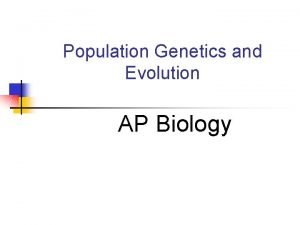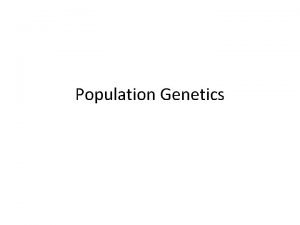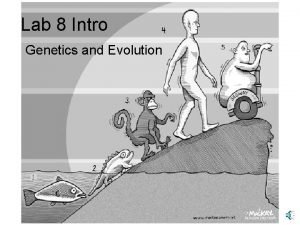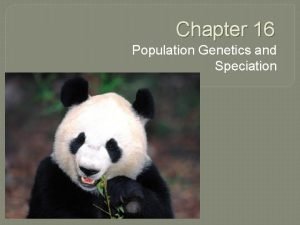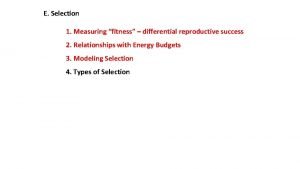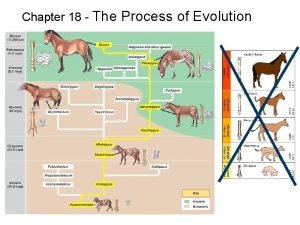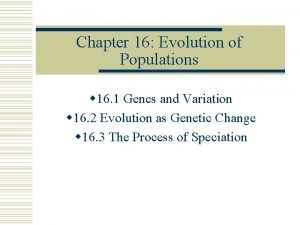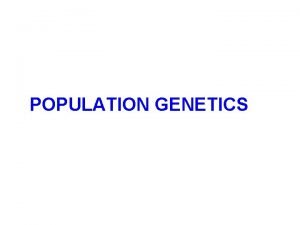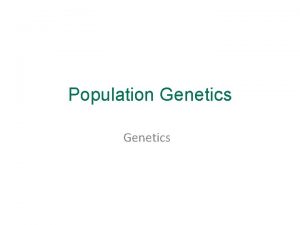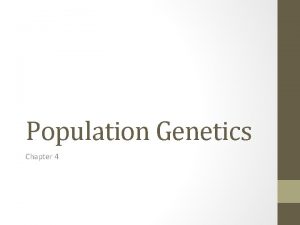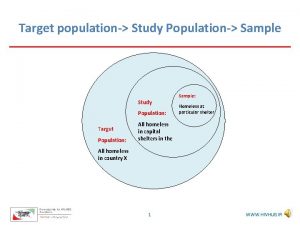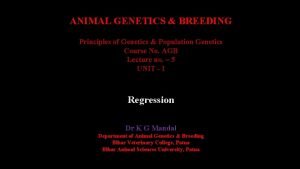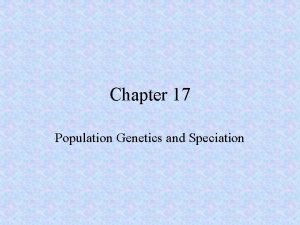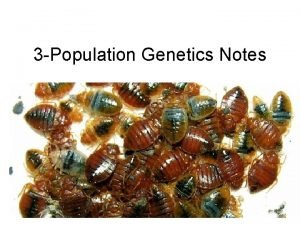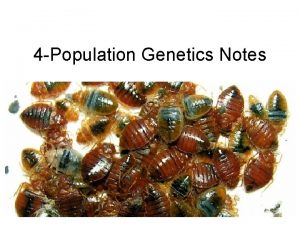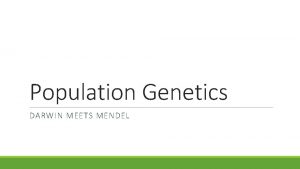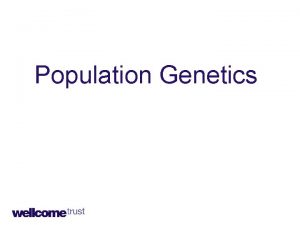POPULATION GENETICS Definition Population genetics is the study














- Slides: 14

POPULATION GENETICS

Definition • Population genetics is the study of distributions and changes of allele frequency in population OR • Population genetics is a subfield of genetics that deals with genetic differences within and between population, and is a part of evolutionary biology. Studies in this branch of biology examine such phenomena as adaptation, speciation and population structure

SOME IMPORTANT TERMS A population is a summation of all the organisms of the same group or species, which live in a geographical area and have the capability of interbreeding. A sexual population is a set of organisms in which any pair of members can breed together. This implies that all members belong to the same species and live near each other. For example, all of the moths of the same species living in an isolated forest are a population.

• A gene pool is the complete set of alleles for a gene in a single population; • The allele frequency for an allele is the fraction of the genes in the pool that is composed of that allele (for example, what fraction of moth coloration genes are the black allele). Evolution occurs when there are changes in the frequencies of alleles within a population; for example, the allele for black color in a population of moths becoming more common.

HARDY (English) WEINBERG (German) PRINCIPLE • Allele and genotype frequencies in a population will remain constant from generation to generation in the absence of forces that change it. • In the simplest case of a single locus with two alleles denoted A and a with frequencies f(A)= p and f(a)= q, respectively, frequencies are • f(AA)= p 2 for the AA homozygotes • f(aa)= q 2 for the aa homozygotes • and f(Aa) = 2 pq for the heterozygotes. the expected genotype

• The genotype proportions p 2, 2 pq, and q 2 are called the Hardy– Weinberg proportions. Note that the sum of all genotype frequencies of this case is the binomial expansion of the square of the sum of p and q, and such a sum, as it represents the total of all possibilities, must be equal to 1. • Therefore (p + q)2 = p 2 + 2 pq + q 2 = 1. The solution of this equation is q = 1 − p.

An Example • Phenylthiocarbamide, also known as phenylthiourea (PTU), is an organosulfur thio urea containing a phenyl ring. It has the unusual property that it either tastes very bitter or is virtually tasteless, depending on the genetic makeup of the taster. The ability to taste PTC is a dominant genetic trait. • T = Dominant = Taster • t = Recessive = Non-Taster

• Consider a population which have • TT / Tt = taster = 50 % • tt = Homozygous non- taster = 50 % • The possible marriages in this population can be: • TT X TT TT X tt Tt X tt tt X tt Sperms Eggs 0. 5 T 0. 5 t 0. 5 T 0. 25 Tt 0. 5 t 0. 25 Tt 0. 25 tt

• So, from the above results we can deduce that: • 25% are homozygous tasters = TT • 50% are heterozygous tasters = Tt • 25% are homozygous non- tasters = tt • So, 75 % in this population will be tasters and 25 % non-tasters • Now if you look at the allele frequency: • Allele T = 0. 25 T (TT) + 0. 25 T (Tt) = 0. 50 = 50 % T • Allele t = 0. 25 t (tt) + 0. 25 t (Tt) = 0. 50 = 50 % t

• Consider another population in which: • Tasters = 20% = TT / Tt • Homozygous non-tasters = 80 % = tt Sperms Eggs 0. 2 T 0. 8 t 0. 2 T 0. 04 TT 0. 16 Tt 0. 8 t 0. 16 Tt 0. 64 tt

So from the above results we can deduce that: • 4 % are homozygous tasters = TT • 32 % are heterozygous tasters = Tt • 64 % are homozygous non- tasters = tt So 36 % in this population will be tasters and 64 % non-tasters Now if you look at the allele frequency: • Allele T = 0. 04 T (TT) + 0. 16 T (Tt) = 0. 20 = 20 % T • Allele t = 0. 64 t (tt) + 0. 16 t (Tt) = 0. 80 = 80 % t

FORCES WHICH CAN AFFECT THE LAW • Mating Choice / Selection • No Mutation in the population • Gene flow (No Migration) • Diseases / Natural disaster deleting a particular allele community • All the members produce fertile gametes

HOW TO DETERMINE ALLELE FREQUENCY • Suppose we take a population in which: 70 % = Taster’s 30 % = Non-Tasters As we know p 2 + 2 pq + q 2 = 1 (q)2 = tt = 0. 3 Taking square root at both sides ʃ (q)2 = ʃ tt = ʃ0. 3 q = t =. 547 p + q = 1 p = 1 -. 547 p = 0. 46

2 pq = 2 (. 547) (0. 46) = 0. 50 So, looking at the equation: q 2=tt= 0. 3 = 30 % non-Taster 2 pq = Tt= 0. 5 p 2 = TT = 0. 2 So, the allele frequency will be t = 0. 3 + 0. 25 =0. 55 T = 0. 2+ 0. 25= 0. 45
 Population genetics definition
Population genetics definition Genetics
Genetics Similar
Similar Population genetics and speciation worksheet answer key
Population genetics and speciation worksheet answer key Population genetics
Population genetics The far side comics
The far side comics Population genetics
Population genetics Genes is the study of heredity and variation
Genes is the study of heredity and variation Extending mendelian genetics
Extending mendelian genetics Population ecology section 1 population dynamics answer key
Population ecology section 1 population dynamics answer key Section 1 population dynamics answer key
Section 1 population dynamics answer key Population ecology section 1 population dynamics
Population ecology section 1 population dynamics Chapter 4 population ecology section 1 population dynamics
Chapter 4 population ecology section 1 population dynamics Hát kết hợp bộ gõ cơ thể
Hát kết hợp bộ gõ cơ thể Ng-html
Ng-html
